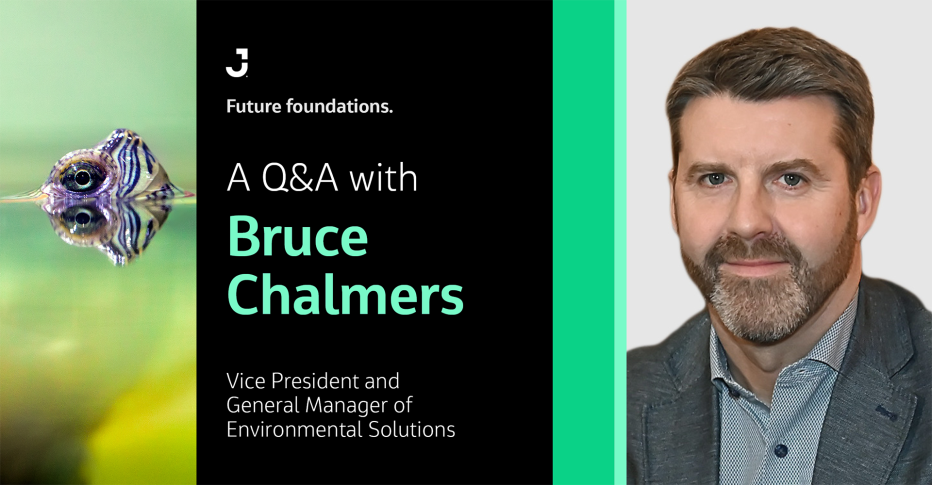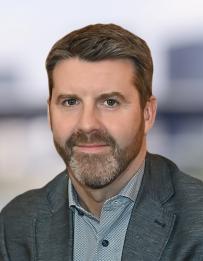A View on the Future of Environmental Solutions: A Q&A With Bruce Chalmers
Vice President and General Manager of Environmental Solutions Bruce Chalmers shares his leadership lessons and sector insights from his 30 years and six rewarding roles at Jacobs

The past few years have taught us several lessons, but the most crucial of them all: we’re not doing enough to protect our environment, and it’s having dire consequences — ecologically, socially and economically.
The climate crisis and extreme weather events provide constant reminders of our need to change, both personally and commercially.
Bruce Chalmers is Vice President and General Manager for our global Environmental Solutions business, bringing together a 2500+ strong talent force, with diverse range of engineering and scientific skills. The team remediates and regenerates sites with complex environmental liabilities, using the best available technology and science, alongside sustainable approaches to planning and permitting of vital new infrastructure across a variety of end markets.
In this article, Bruce shares insights from his global career, including technical, sales and operational roles, and powerful leadership lessons.
What are the biggest challenges in environmental solutions?
Nature-based solutions can unlock multiple benefits in a sustained response to climate change for many of our clients and communities — from carbon sequestration to preserving our water, mitigating flood risk and enhancing our biodiversity.
Additionally, remediation and regeneration are crucial to dealing with the legacy of industrial contaminants that pollute our environment and impact biodiversity and socioeconomic opportunities.
From a data and technology perspective, gathering, evaluating and reporting on vast quantities of diverse data sources across soil, air, water, flora and fauna is critical to driving efficiencies.
In summary, all clients will need some form of support in sustainability and environmental capabilities, and that is where we offer our cross-sector expertise, trusted insights and regional lessons to provide the best environmental planning and support services.
How do we help clients think differently to respond to these future challenges?
We support across geographies through catchment and system-level approaches, not just single projects or locations. We also support clients with rapidly changing regulatory and compliance legislation, as we have regional expertise in supporting and tracking the work and changes needed. Considering the greater media and shareholder scrutiny on environmental outcomes as part of the bottom line, a much higher level of stakeholder engagement is required.
This is where our strength in collaboration and our relationship-based business model aligns perfectly with the United Nations Sustainable Development Goal #17, which focuses on strategic and global partnerships.
What are the biggest misconceptions about the environment market?
Two of the most pervasive ones are that the sector is seen as solely focused on the preservation of flora and fauna and that clients are forced to adhere from a regulatory perspective. However, the mindset has evolved hugely in the past ten years. Now, it’s seamlessly integrated into everything we do. It enables projects, adds value and ensures we stay true to our purpose of making the world a more connected and sustainable place.
How do you define your market capabilities and services?
We look at it through three primary lenses. Firstly, there’s remediation and regeneration, where we provide an end-to-end service to many federal and industrial clients around the clean-up of sites and management of environmental liabilities and, in some cases, transformation of land management outcomes. These legacy issues are often extremely complex high-end scientific challenges in complex regulatory landscapes and we utilize truly global expertise and solutions, including digital analytics tools and models, from investigation to remediation design to optimize management of risk and protection of the environment and communities.
The second lens is environmental planning, a capability that supports all our vertical end markets with assessment, consenting and permitting — typically related to new infrastructure projects. We have consented on some of the largest infrastructure projects around the globe, sharing lessons learned across our clients and developing a range of digital tools that enable better, quicker outcomes through these challenging project phases.
Lastly, we have operational excellence, where we support a diverse range of public and private sector clients in managing and optimizing their operational compliance in a regulatory sense but also increasingly around their ESG goals and mission. We help clients define how they deliver upon their goals and mission, and that draws in both our talent and solutions. Many of these clients have large global footprints, so the requirements can be complex.
So yes, we are helping to protect flora and fauna but we’re also unlocking the triple-bottom-line value beyond compliance. The sector is a real enabler in delivering and integrating major infrastructure, which is fundamental to our global economies.
What are the biggest opportunities ahead for environmental solutions?
This will sound a little predictable, but it’s around big data. We’re collecting, measuring and analyzing environmental data on a huge scale in different types and formats, whether that's greenhouse gas (GHG) emissions, noise or air quality, waste, water quality or data around flora and fauna. These are large complex data sets collected over long periods. We're testing opportunities for machine learning and AI in these areas. The better we get, the more valuable the insights and the more significant impact we can have. There’s also a productivity challenge in many parts of the world, so we've got to figure out how to embrace new ways of working alongside technology and data to unlock higher productivity.
We’re remaining at the front of this trend as isolated digital tools and capabilities move to scale on a more integrated basis to deliver faster, higher-quality environmental services on a repeatable basis for our clients.
Secondly, we’re seeing much more success on a systems- and catchment-level thinking approaches and partnerships where we are bringing together broad capabilities and thinking across markets, client and communities on a regional system basis. Instead of focusing on one localized impact, we’re seeing how companies, local authorities and governments can work together for much greater collaboration and problem solving and better outcomes.
Lastly, the field of green investment is evolving rapidly, and private and public companies have plenty of opportunities to have a more significant impact. The potential for increased monetization of eco-system services will make nature-based solutions more viable, both technically and commercially, to solve some of our greatest challenges around emissions, habitat protection, water scarcity and climate resilience. For example, we’re guiding the development of a new code in the U.K. that will set regulatory standards for carbon-capturing coastal marshland — sometimes referred to as Blue Carbon — we need to codify these scientific advances to move these solutions to broad adoption at scale.
About the interviewee

Bruce Chalmers is an accomplished business leader, problem-solver and innovator with over 30 years of experience across a broad range of sectors, including nuclear, defense, transport, buildings, water, energy and environmental. Bruce is now leading our global Environmental Solutions business, with a $1bn annual turnover.
Bruce started his career as a civil engineer working in the nuclear and defense sectors but quickly established key project and stakeholder management skills that enabled him to take assignments in Malaysia on a large-scale retail development before an extended period supporting the growth of the transportation business back in the U.K. and Ireland. Over the last ten years, Bruce has spent more time helping clients in the water and environmental markets by collaborating to implement innovative commercial and technical solutions that deliver on stakeholder outcomes. Bruce loves working in partnership with clients to solve their toughest challenges through the power of Jacobs’ global solutions.
You might be interested in...
Future Foundations.
Co-creating the world to come

From developing climate resilience and transitioning to a low-carbon future, to modernizing and transforming infrastructure, governments and businesses face critical challenges. How they respond will define our future.
As our clients navigate these challenges, we help them think differently – working together to pioneer tomorrow's infrastructure solutions and build the foundations for a prosperous, secure future.














































